Want to study smarter in 2025? These top 10 study tips are based on how real students learn today—practical, tech-aware, and built for modern classrooms.
Introduction
Studying today isn’t about burying your head in a textbook for hours. In 2025, students deal with online lectures, AI tools, hybrid classes, and an overload of distractions. That’s why having solid, realistic study strategies makes all the difference. If you’re a student or an educator helping one, these 10 tips are designed to fit right into this year’s learning world—no fluff, just useful advice that works.
1. Set Goals That Actually Help You
Generic goals don’t help anyone. Saying “I need to study more” is too vague. You need a plan that’s clear and doable.
Better idea: Set goals like “Finish math assignment by 3 PM and review lecture notes for 20 minutes.”
Use tools you’re already familiar with—maybe it’s your phone’s reminder app, or a to-do list on Google Keep. Keep it simple and focused.
2. Learn by Doing, Not Just Reading
Reading your notes isn’t enough. You’ll retain more if you do something with the information.
Try this:
- Quiz yourself out loud.
- Explain the topic to a classmate (or even your pet—it helps!).
- Turn key points into a simple sketch or mind map.
Apps like Quizlet are helpful, but even making your own flashcards by hand can be super effective.
3. Use AI Tools, But Don’t Rely on Them
Yes, AI tools like ChatGPT, Grammarly, or Notion AI can save time and explain things better than a textbook sometimes. But they’re just that—tools. They’re not your teachers or your brains.
Use them to:
- Get feedback on writing.
- Understand tough topics in plain language.
- Create a study outline quickly.
Still, always double-check facts and do your own thinking. That’s what makes the learning stick.
4. Build a Study Space That Works for You
Your surroundings matter more than you think. Studying on your bed with TikTok open isn’t ideal.
Try this:
- Find a quiet spot, even if it’s just a corner of the room.
- Keep your desk clean—less clutter, more focus.
- If you can’t avoid noise, get some headphones and try background sounds (like lo-fi or nature sounds).
Make your space a place you want to return to.
5. Make Studying a Habit, Not a Panic Response
Waiting until the night before an exam is a recipe for stress. Instead, build a routine.
One popular method is the Pomodoro Technique:
- Study 25 minutes
- Take a 5-minute break
- Repeat
After 4 rounds, take a longer break. Your brain stays fresh, and tasks feel less heavy. Put this on your calendar and treat it like a class—non-negotiable.
6. Take Care of Your Mind and Body
Your brain can’t work right if your body’s drained. Caffeine and all-nighters might work once, but not for the long haul.
Stick to basics:
- Sleep 7–8 hours a night
- Drink water (not just energy drinks)
- Move around a little—walks, stretching, or short workouts help
Also, don’t ignore your stress levels. Try journaling, talking to someone, or using mindfulness apps. Mental health is part of academic success.
7. Make Study Groups Work (Not Waste Time)
Study groups can be amazing—or a total mess. The key is structure.
Here’s how to do it right:
- Keep it small (3–4 people)
- Meet with a goal (like reviewing a specific topic)
- Use shared docs so everyone contributes
Use group chats to stay in touch, but don’t let them become meme zones. If the group isn’t helping, it’s okay to move on.
8. Check In With Yourself Weekly
You don’t need a teacher to tell you how you’re doing. You can figure that out with a quick weekly check-in.
Ask yourself:
- What did I learn this week?
- What am I still confused about?
- What should I focus on next?
Keep a simple notebook or digital doc for these reflections. You’ll start to see patterns—and fix problems early.
9. Find Your Best Learning Style
Some people need visuals. Others need to hear things or write them out. You probably already have a sense of what clicks for you.
Try this:
- Visual learner? Draw diagrams, use videos, and color-code your notes.
- Auditory learner? Use text-to-speech apps or record yourself.
- Hands-on learner? Walk around while reviewing, or turn facts into physical movements.
Mix and match until you figure out what sticks. There’s no “right” way to learn.
10. Stay Flexible and Keep Learning How to Learn
The world—and school—changes fast. New tools, new formats, new expectations. The students who do best in 2025 are the ones who adapt.
Don’t get stuck doing things the way you always have. Try new tools, take feedback, and change up your study habits when they stop working.
Stay curious. Stay open.
Conclusion
Studying in 2025 isn’t just about grinding—it’s about being smart, intentional, and a little tech-savvy. With these 10 tips, you’ve got a starting point that reflects real life, not some outdated routine.
Start small. Maybe choose two tips and make them a habit. Once those feel natural, add more. Every step counts.
Want to remember these tips? Bookmark this page and share it with a friend. Better study days start now.
